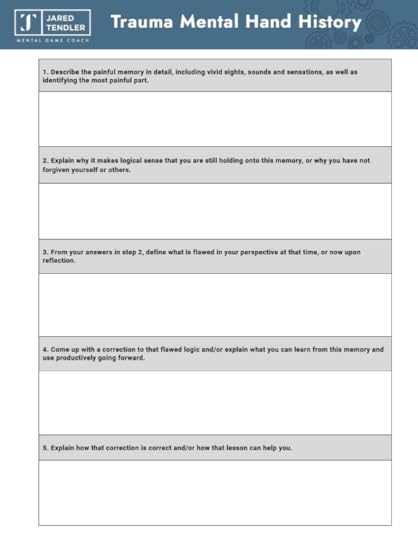Insights from (Another) Failure

156 players will be teeing up this week at the US Open and I will not be one of them. It would have been surprising if I was one of them, but that never stopped me from dreaming.
Over the last 28 years I have tried and failed to qualify for the US Open multiple times. I wasn’t expecting to qualify this year, and wasn’t even going to tee it up either, but the first stage of qualifying happened to be at my home course and so I had to give it a shot.
The good news is that I played significantly better than I have in the last several years and came to the last hole knowing that I was two shots out of a playoff and needed to hole out for eagle from 165 yards. I even had that opportunity because I birdied the 16th and 17th holes – almost making eagle on both too. While I didn’t dunk my second shot on the last hole, I was proud of how well I competed and how well I played all the way around. I hit a lot of great shots. Had a few marginal ones that got some bad breaks, but I didn’t let them affect me, hung in there and gave myself a chance.
Most importantly, I made all the short putts that I needed to. Something I didn’t do in my first attempt 28 years prior where I missed four putts inside of four feet and was on the outside of a playoff by just a single shot. The pressure got to me that year, but it was ultimately a catalyst for my career as a mental game coach.
Truth be told, my insights about failure didn’t come during or after the round. They actually came beforehand, while examining my pre-tournament nerves.
It occurred to me that I’ve been trying to qualify for this tournament for close to three decades and just being here, trying once again, was actually an accomplishment.
My failures haven’t killed or maimed me, they’ve made me stronger. I’m still willing to get up and give it another go, throw myself into the fire to see what I can do. I’m not beaten down, I’m still aspirational, and that’s something worth celebrating.
That realization alone helped some of the nerves melt away instantly.
The past was not hanging over me like an imposing force, adding more pressure to make this year the year that I finally realized a dream. No. It wasn’t about the past anymore. I was proud to still have an opportunity right in front of me and it demanded my full focus.
I know I’m not alone here – whether you’re competing in trading, poker, or golf, the struggle is real. Some of you have struggled for years to break through and achieve the level of success you want.
This is especially true in trading and poker where “breakthrough” moments are often harder to define because there is no trophy, or they’re few and far between. You’re instead trying to unlock distinct points of success – breaking even and not losing money, starting to make money, making money consistently, making good money, and realizing your dreams – when you struggle to reach a benchmark, sometimes for years, the strain of past failures can wear on you, making you hungry or more desperate for success right now.
At times, each failure feels like you’re digging a deeper hole, falling farther and farther behind where you want, or expect, yourself to be. Each day, each trade, each poker session, each round of golf, become evidence of progress or proof that you’re still stuck in a place you don’t want to be.
Converting Failure from a Liability to an Asset
Past failures, struggles, mistakes can loom large in your mind. Even though you may not have them consciously in your mind while trading, playing poker or golf, your overall emotional temperature is raised.
You react more intensively to bad breaks, losses, mistakes, or poor results. You also react more positively to great days, feeling like you’ve finally turned the corner, except you might be fueling overconfidence and can easily get knocked back down.
When that happens, your mind goes into overdrive trying to figure out how to be better and avoid repetitive mistakes that you thought were corrected. You feel compelled to do something special to get to the place you want to be and that makes you gamble, take bigger risks, or get stuck in the “f its,” just hoping that you can find your way out.
The thing is, past failures offer a lot of insight. Practicing before the US Open qualifier, I hit a really poor second shot on the opening hole, and part of me wanted to hit it again. But I knew exactly what went wrong – I didn’t have a detailed picture of what I wanted to do with the shot. I was too relaxed. Rather than hit the shot again, I wanted the consequence, to learn the lesson.
Our failures offer us a lot of insights but too often we are so results-oriented that we only focus on the failure itself. We don’t dig into what went wrong, don’t allow our problem-solving abilities to work for us and fail to understand why we failed.
Some of those answers might be technical and beyond the scope of this blog. But when the reasons are mental and emotional, the answers are out there for those who are willing to dig deeper than what’s obvious. This is most needed when you are stuck in a cycle where you keep making the same mistakes again and again.
There’s the classic quote from Einstein, about the definition of insanity being doing the same thing over and over and expecting different results.
In my experience, it’s less about insanity and more about overconfidence.
Yes, when you’re in a lot of emotional pain and you think you have an answer but the evidence shows that you don’t, you’re overconfident.
Overconfidence is a common, yet hidden reason why failures of the past continue to loom large. It prevents you from understanding why you’re actually failing or struggling, you just assume you already know why.
The reality is that what you’re currently doing isn’t enough, you don’t have an answer yet. That’s ok. This level of honesty is an important starting point for helping you to turn your failures into an asset that you can use to make you stronger and more capable.
Sometimes there are valuable lessons to take away from failure. For example, after failing to qualify last year, I decided to change how I’m approaching the tournament this year. I stopped trying to improve my golf swing, having made some significant improvements the last few years. What was lacking now, was a clear picture of what I wanted to do with each shot. My decision-making process was weak from spending more focus on actively trying to improve my swing and technique.
There are many lessons you can learn from your past failures, both technically and mentally. As long as you don’t view failure as permanent, all that information from your past can be converted into an asset by going back through your failures to extract the lessons and learnings left behind.
Accumulated Emotion
For some of you it’s not about converting a failure into some objective takeaways that can help you progress. The problem is that old emotions from past failures are locked inside and they can very quickly flood your mind today.
Accumulated Emotion is a wild card that can explain why your emotions become intense so quickly, why you can’t adhere to your trading strategy or rules even though you “know better”, and why you can struggle so much to gain command of your emotions even using my system.
The reality is, emotions are messy. They build up in both the short term and the long term. And while the brain has a natural digestion process for emotion, sometimes there’s residual emotion left over—this is accumulated emotion.
We often call it emotional baggage, scar tissue, or trauma. Don’t let the trauma word scare you. It’s just a measure of how much the past is ever present. When emotion from the past is unresolved, it remains intact and becomes capable of being triggered. You’re trying to do your absolute best to be successful today, all while dealing with emotions that make it an unfair fight. And past failures can really stick with us.
The way to crack through them is using an adapted version of the Mental Hand History called the Trauma Mental Hand History (below), which just changes a couple of questions to help you figure out why you are still holding on to that emotion from the past.

Time does not heal all wounds. These emotions may not go away just because you say you’re “letting go” of the past.
Scar tissue in the mind is like scar tissue elsewhere in the body. It builds up to provide protection against injury or pain. Just saying I’m letting go of scar tissue in my quad doesn’t mean it’s gone. I still can’t stretch that muscle fully until I work through it and it’s often painful to do so. But it’s pain with a purpose.
It’s very common that flaws in the past are still active, affecting you today and part of the reason why you’re not able to break through. Revisiting these memories is not about trying to torture yourself and re-experience old pain again. It’s about examining the past to identify the flaws, biases, wishes, hopes keeping the emotional pain frozen in your mind, preventing you from truly moving on from the past.
It’s about figuring out what you need to learn to be able to use your past as the asset that it really is.
If you’d like my blog delivered right to your inbox, click here to be added to the list.
The post Insights from (Another) Failure appeared first on Jared Tendler.



